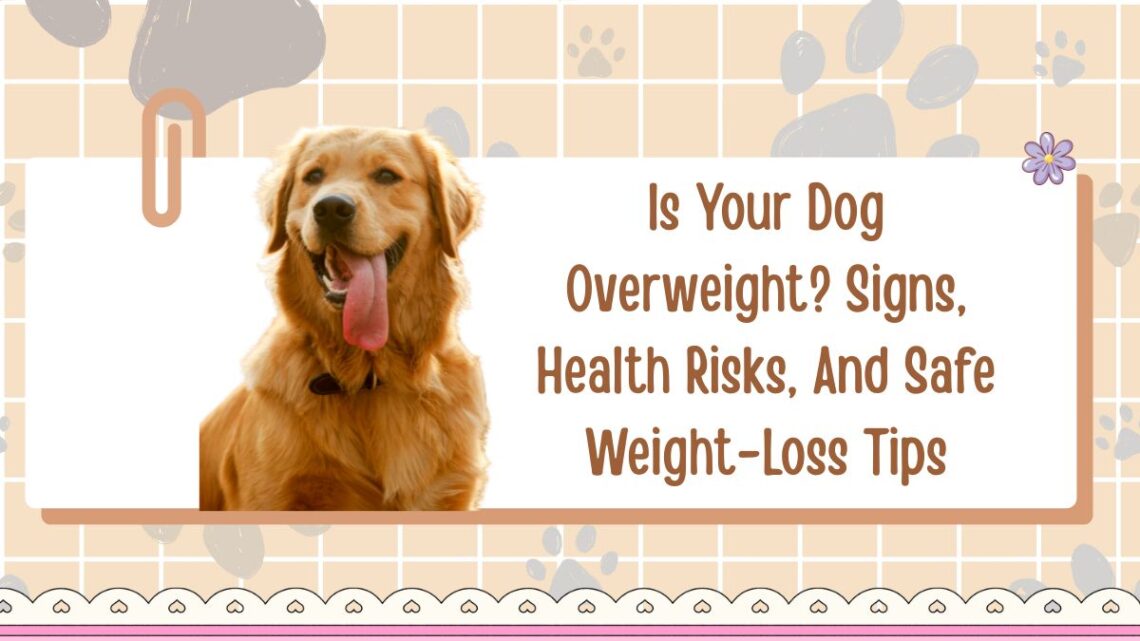Is your dog looking a little rounder than usual? You’re not alone in wondering. Studies show that over 55% of dogs in the U.S. are either overweight or obese—a number that continues to climb each year.
While a little extra pudge might look cute, excess weight can have serious health consequences for your furry friend. It can shorten lifespan, increase the risk of chronic diseases, and reduce quality of life.
The good news? With proper awareness, nutrition, and care, you can help your dog safely achieve a healthy weight and stay that way.
How to Tell if Your Dog Is Overweight
1. The Rib Test
A quick at-home method: run your hands gently along your dog’s sides. You should be able to feel the ribs easily without pressing hard, but not see them protruding. If you have to dig through fat to find them, your dog is likely overweight.
2. Look from Above
Stand over your dog and observe their shape. A healthy dog will have an hourglass figure, with a visible waist behind the ribs. If your dog looks oval or barrel-shaped, they may be carrying extra fat.
3. The Side View
From the side, your dog’s belly should tuck upward slightly behind the ribcage. A flat or sagging belly indicates excess abdominal fat.
4. Behavioral Clues
An overweight dog may show signs like:
- Difficulty climbing stairs or jumping
- Quick fatigue during walks
- Heavy panting after mild activity
- Tight collars or harnesses that once fit comfortably
Body Condition Score (BCS)
Veterinarians use the Body Condition Score (BCS) system to determine your dog’s ideal weight. This scale runs from 1 to 9, where 1 means emaciated, 5 means ideal, and 9 means severely obese.
Each point above ideal (5) represents roughly 10% excess body fat.
For example, if your Labrador Retriever weighs 80 pounds but should weigh 65, that’s about 23% over ideal weight, meaning they should gradually lose 15 pounds under veterinary supervision.
Key Signs of Overweight Dogs
| Sign | Description |
|---|---|
| Hard-to-feel ribs | Fat covering prevents you from easily feeling ribs |
| No visible waistline | Body appears rectangular or round |
| Sagging stomach | Lack of upward abdominal tuck |
| Panting or tiring quickly | Indicates reduced stamina |
| Trouble walking or climbing | Joint pressure from excess weight |
| Increased appetite | May indicate hormonal imbalance or habit feeding |
Health Risks of Canine Obesity
Carrying extra pounds isn’t just a cosmetic issue—it’s a serious health threat that can affect nearly every organ system. Here are the most common problems:
- Arthritis and Joint Pain: Every extra pound adds stress to your dog’s hips, knees, and back. Overweight dogs are far more likely to suffer from arthritis and torn ligaments.
- Heart Disease and Hypertension: Fat buildup puts extra pressure on the heart, reducing oxygen efficiency.
- Diabetes: Overweight dogs are at high risk for insulin resistance and blood sugar instability.
- Shortened Lifespan: Studies show that obesity can shorten a dog’s life by up to 2.5 years.
- Breathing Problems: Excess fat around the chest limits lung expansion.
- Heat Intolerance: Overweight dogs overheat faster and are prone to heatstroke.
Common Causes of Weight Gain in Dogs
- Overfeeding: Even a small daily calorie surplus adds up over time.
- Too Many Treats: Treats should make up no more than 10% of daily calories.
- Lack of Exercise: Indoor lifestyles and busy owners mean less playtime.
- Table Scraps: Human foods are high in fat and salt, which can spike weight gain.
- Neutering/Spaying: Hormonal changes may slightly lower metabolism, requiring dietary adjustments.
- Health Conditions: Thyroid issues and Cushing’s disease can cause weight gain.
How to Help Your Dog Lose Weight Safely
Step 1: Consult Your Veterinarian
Before changing anything, schedule a vet checkup. They’ll rule out underlying health problems and help determine your dog’s target weight and calorie needs.
Step 2: Switch to a Weight-Management Diet
Choose a high-fiber, low-fat formula designed for weight loss. Fiber keeps your dog feeling full, while fewer calories help burn stored fat. Measure meals carefully—avoid free-feeding (leaving food out all day).
Step 3: Limit Treats
Treats are fine in moderation but choose low-calorie options like small pieces of apple, carrot sticks, or green beans. Avoid fatty biscuits or table scraps.
Step 4: Increase Physical Activity
Start slow and build endurance.
- Begin with 10–15-minute walks twice a day.
- Gradually increase duration and intensity.
- Add fun exercises like fetch, swimming, or agility play.
Aim for at least 30 minutes of daily movement, depending on breed and age.
Step 5: Track Progress
Weigh your dog every 2–4 weeks. Healthy weight loss should be 1–2% of body weight per week. Keep a record of weight, food intake, and activity level to share with your vet.
Safe Weight-Loss Timeline by Dog Size
| Dog Size | Average Weight Range (lbs) | Weekly Weight Loss Goal | Expected Duration (Months) |
|---|---|---|---|
| Small (10–25 lbs) | 0.1 – 0.3 lbs | 10–12 weeks | |
| Medium (25–60 lbs) | 0.3 – 0.7 lbs | 12–16 weeks | |
| Large (60–100 lbs) | 0.7 – 1.2 lbs | 16–20 weeks | |
| Giant (100+ lbs) | 1.2 – 2.0 lbs | 20–24 weeks |
Note: Always consult your vet before starting any weight-loss program.
Lifestyle Tips for Long-Term Maintenance
- Feed at consistent times: Routine meals prevent overeating.
- Use slow-feeder bowls: Helps prevent gulping and overeating.
- Avoid guilt feeding: Don’t use treats to replace attention—play instead.
- Involve the whole family: Everyone should follow the same feeding rules.
- Regular checkups: Biannual vet visits can help catch weight changes early.
When Weight Loss Isn’t Working
If your dog’s weight doesn’t improve after a few months, don’t get discouraged. It may indicate:
- Miscalculated calorie needs
- Hidden snacks or table scraps
- Underlying hormonal issues
Your veterinarian can adjust the diet plan or run diagnostic tests to identify the cause.
Benefits of a Healthy Weight
Helping your dog maintain a healthy weight pays off in many ways:
- Increased energy and playfulness
- Improved joint health and mobility
- Lower medical costs long term
- Stronger immune system
- Longer, happier life
Your dog’s weight is more than a number—it’s a reflection of their overall health and happiness. An overweight dog may seem content at first, but the long-term effects can be devastating.
Recognizing the signs early, making small dietary changes, and increasing daily activity can transform your dog’s health.
By committing to consistent care, portion control, and regular vet checkups, you can help your furry friend reach a healthy weight—and keep that tail wagging for years to come.
FAQs
Calorie requirements depend on breed, age, and activity level. Your vet can help estimate the right calorie range to support gradual, healthy weight loss.
No. Many human diet foods contain artificial sweeteners and ingredients that are toxic to dogs, such as xylitol. Always use dog-specific formulas.
Introduce new food gradually—mix it with their old food over a week. Add a splash of warm water or low-sodium broth to make it more appealing.






